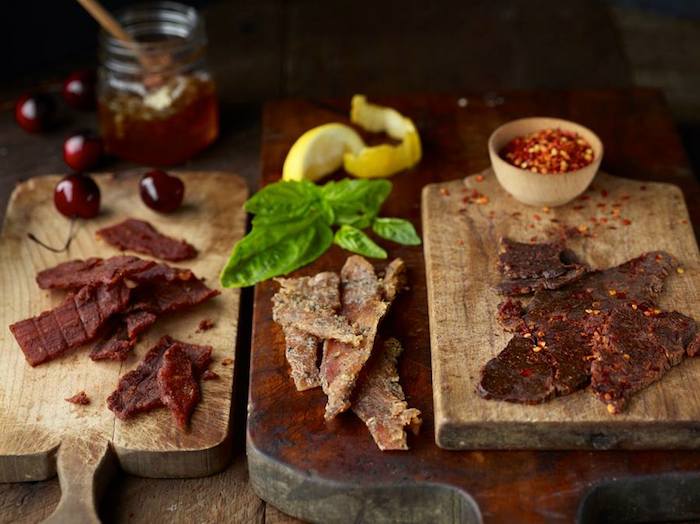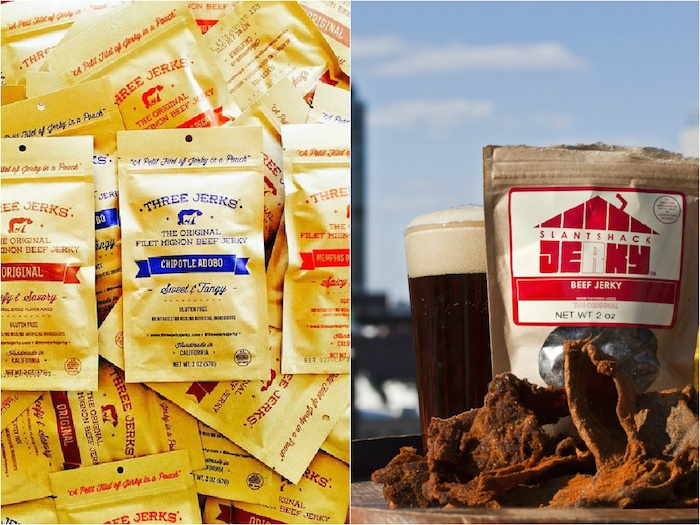
Let's make one thing really clear: this story is not going to give you license to bite into a Slim Jim in the name of nutrition. But beef jerky is most definitely transitioning from a gas station bad habit into a trendy health food.
As the snack darling of the Paleo Diet, cured meat may be the new kale chip. The proof is in Paleo bloggers like Stupid, Easy, Paleo and Nom, Nom, Paleo posting about making it themselves, as well as the many companies now selling their better-for-you jerkies to healthy eaters all over the country.
And we're not talking about it being available only at interstate truck stops. Krave Jerky counts healthy-living fanatic Jillian Michaels among its ambassadors and sells its extensive list of flavors at discerning national chains like Whole Foods and yoga festivals like Wanderlust. The jerky is even infiltrating the healthy city scene, with indie brands like filet-mignon-inspired Three Jerks in Los Angeles and SlantShack in New York City.

"Portable protein is really challenging to find in a healthy source—jerky is perfect when you don’t have time to grill up a steak or sear a chicken breast," says Whole30 co-founder Melissa Hartwig, a sports nutritionist and the co-author of the new book Whole30: The 30-Day Guide to Total Health and Food Freedom, out in April.
Meet the (not so scary) ingredients
The most important thing to know about the new beef jerky is that it has little in common with the aforementioned Slim Jim—outside of, you know, the meat.
This version is often organic and/or grass-fed, and ingredient lists are free of added sugar, sodium, MSG and preservatives. Three Jerks even switched from using soy sauce to tamari to make its products gluten-free.
And while traditional jerkies are infamously cured with nitrates and nitrites—compounds with many purported health risks (and classified as "probably carcinogenic to humans" by the International Agency for Research on Cancer)—these are more like the steak you might eat at a restaurant...just dehydrated, baked, or cured using natural ingredients.

Why people are obsessed with the new beef jerkies

{{post.sponsorText}}
Since eating Paleo is all about going back to basics, making jerky at home is simply another way to satisfy that urge, just like, say, fermenting. But for those who are a little lazier (or busier), the new foodie flair this crop of brands offers is a super flavorful bonus.
"It's no longer just this dry, tough strip of plain old meat," says Hartwig, who's a fan of and has partnered with the brand Primal Pacs. "There are so many varieties of healthy jerky these days, you can satisfy any taste or texture preference."
I certainly experienced that while taste testing (with the generous help of my significant other). These jerkies are chewier and more tender than the overly processed version. With brands like SlantShack that use 100-percent grass-fed beef, the flavor is rich and meaty, and they then up the culinary ante with flavors like Vermont Maple Glaze and Garlic Powder.
Krave not only has unique flavor pairings, but they use meats other than beef, too (their Turkey Basil Citrus was one of our favorites). And Primal Pacs even mixes its jerky with ingredients like dried fruit and nuts, making it a sort of meaty trail mix (in the yummiest way possible).
Because, so what if ancient man didn't have access to organic grass-fed jerky with roasted salted macadamia nuts and dried mango in a conveniently packaged resealable bag? We do. —Lisa Elaine Held
(Photos from top: Krave Jerky, Melissa Hartwig via Whole 30, Three Jerks Jerky and SlantShack Jerky)
Loading More Posts...